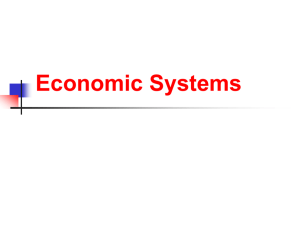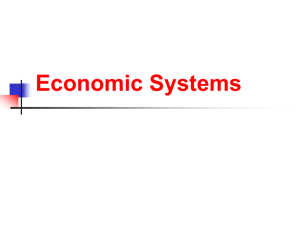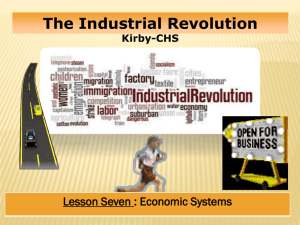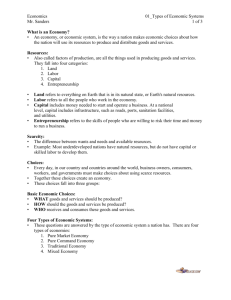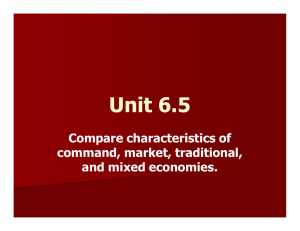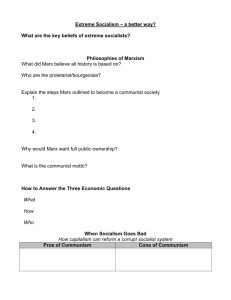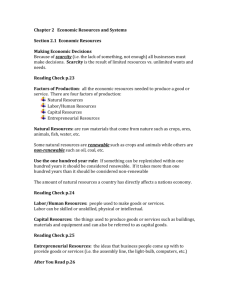Chapter 26.2
advertisement
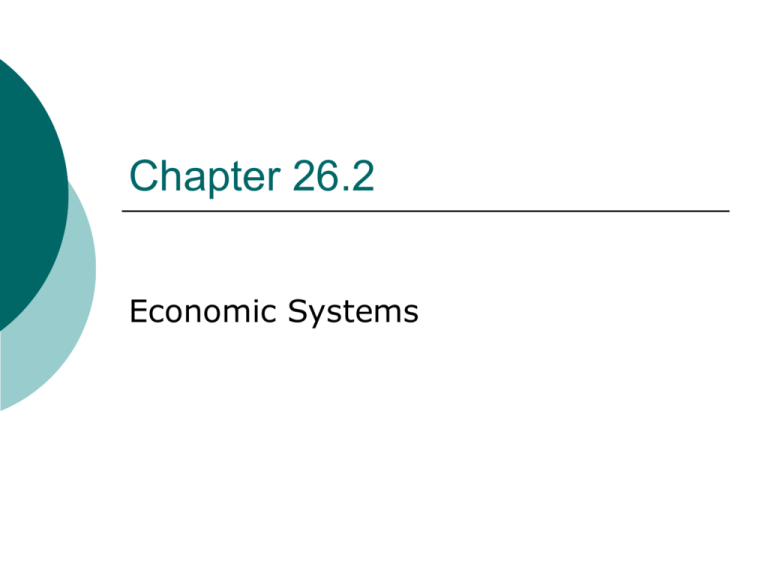
Chapter 26.2 Economic Systems Market Economies The way a society answers the basic economic questions of what to produce, how to produce and for whom to produce determines its economic system. In a pure market economy, also called capitalism, these decisions are made in free markets by the interaction of supply and demand. continued In a market economy, private citizens – not the gov’t – own the factors of production: natural resources, capital, labor and entrepreneurship Driven by the desire to earn a profit, businesses make their own decisions regarding what, how and for whom to produce. At the same time, consumers make their own decisions about what to buy. continued Supply and demand interact in the market to set prices and producers and consumers base their decisions on price. A market economy is decentralized – decisions are made by all people, not just a few. No one coordinates these decisions. continued In the U.S., the gov’t play several important roles in the economy. It provides public goods. It regulates businesses to make sure markets stay competitive. It works to reduce negative externalities and increase positive externalities. continued Dividing GDP by a country’s population yields the country’s per capita GDP. By expressing GDP in terms of each person, we can compare one nation’s economic success to another without regard to the size of the two economies. Most countries with high per capita GDP’s have market economies. Command Economies In a pure command economy, the central gov’t makes the major economic decisions. Individuals have few choices and little influence over the economy. This system has also been called a controlled economy, socialism or communism. continued Socialism is the belief that the means of production should be owned and controlled by society, either directly or through the gov’t. In this way, socialists felt that wealth would be distributed equally among all citizens. continued Karl Marx, a German thinker, was a socialist. He believed that industrialized nations were divided into capitalists (bourgeoisie) who own the means of production and workers (proletariat), who work to produce the goods. Marx saw history as a class struggle in which the workers would eventually overthrow the capitalists. continued Marx believed that in time, socialism would develop into communism. Under communism one class would evolve, property would all be held in common and there would be no need for gov’t. continued In a command economy, the gov’t owns most productive resources, especially land and capital. The gov’t makes the three basic economic decisions. It tells producers what to produce, how to produce and for whom to produce. The gov’t fixes the wages of workers and sets prices. continued Gov’t planning agencies control different parts of the economy, such as agriculture and steel production. Command economies can be very inefficient, resulting in slower growth and lower per capita GDPs than market economies. The two leading command economies are Cub and North Korea. Mixed Economy A mixed economy combines basic elements of a pure market economy and a command economy. Most countries have a mixed economy that combines private ownership of property and individual decision making with gov’t intervention and regulations. continued In the U.S., individuals make decisions based on market phenomena. However, the gov’ts make laws to protect private property and regulate areas of business.
